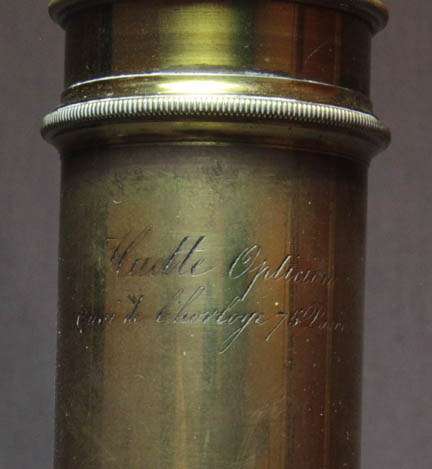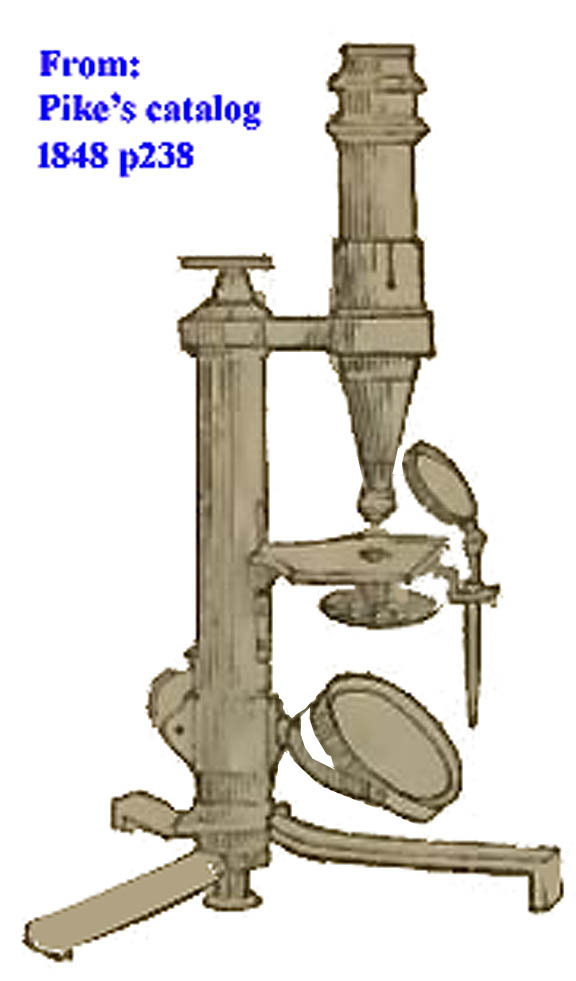PORTABLE COMPOUND MICROSCOPE
SOLD BY: HUETTE
ATTRIBUTED MAKER: NOEL F.J. BURON (A)
c. 1840's
SIGNED: 'Huette Opticien, Quai de l'Horloge, Paris '
MODEL: 'LARGE MODEL WITH FOLDING TRIPOD'
Please Click On Any Picture for a Larger Version
DESCRIPTION:
 This is a portable compound monocular microscope with a folding tripod foot. Coarse focus is by sliding the tube and fine by knurled knob at the top of the pillar acting on the stage support. The unlaquered tube is signed: 'Huette Opticien, Quai de l'Horloge, Paris '. The arm can be swung aside and there are stops for the normal forward position, and 90 degrees to the right. The single-sided mirror is concave and rests in a gimbal. The collar supporting the mirror can be adjusted up or down on the pillar and clamped in place by a knurled knob. The mirror collar has a slot to keep it centered on a rail as it is moved up and down. There was a single original eyepiece and a single achromatic aplanatic objective with a focal length of about 1.5 inches. This objective can reach focus on the stage with the tube raised in the collar and the stage at about its lowest level as controlled by the fine focus knob. I have substituted a Nachet objective of higher power which is much more like the original objective supplied.
This is a portable compound monocular microscope with a folding tripod foot. Coarse focus is by sliding the tube and fine by knurled knob at the top of the pillar acting on the stage support. The unlaquered tube is signed: 'Huette Opticien, Quai de l'Horloge, Paris '. The arm can be swung aside and there are stops for the normal forward position, and 90 degrees to the right. The single-sided mirror is concave and rests in a gimbal. The collar supporting the mirror can be adjusted up or down on the pillar and clamped in place by a knurled knob. The mirror collar has a slot to keep it centered on a rail as it is moved up and down. There was a single original eyepiece and a single achromatic aplanatic objective with a focal length of about 1.5 inches. This objective can reach focus on the stage with the tube raised in the collar and the stage at about its lowest level as controlled by the fine focus knob. I have substituted a Nachet objective of higher power which is much more like the original objective supplied.
HISTORY OF THE HUETTE
MICROSCOPE:
Most historians attribute the first French achromatic lenses to Selligue and Chevalier about 1823 and 1824 respectively. These were stacked doublets, now referred to as button
objectives. Huette, (not to be confused with the earlier Huette of Nantes), is well known as an Ingénieur opticien
from the 1830s. He was established at 75 Quai de l'horloge in Paris, thus matching the signature on this microscope.
On the other hand, this microscope was offered by the manufacturing optician Buron in his 1844 wholesale catalog, where he specifically stated in the introduction, that it was: a catalogue which is not intended for the public, and which will mainly reside between the hands of dealers
. Buron further boasted that he owned the largest optical instrument factory in the world
. It is of interest that an unsigned microscope almost identical to that pictured on this page, is in the Science museum in London, where it is attributed to Lerebours. Lerebours were in business in Paris from 1790s to about 1845 and were known to be associated with Buron.
This model of microscope was likely first made in the period of transition from non-achromatic microscopes to achromatic models. The first French achromatic microscopes made use of stacks of achromatic doublets we now refer to as 'button' objectives, and indeed the catalog entries, as well as the example in the London Science Museum, show this microscope with those. This example is slightly different in that it has a longer barrel objective which may reflect an early adaptation to the aplanatic and achromatic objective that was becoming commercialized starting about 1839. The thread on this objective is unique, is not an RMS thread, and does not depend on an adapter, and therefore was clearly designed for this microscope.
 This model is virtually identical to a model imported into the USA as noted in the Pike's catalog of 1848. Bracegirdle believed that the unsigned, but otherwise identical example in the London Science Museum collection could be a Chevalier product, perhaps because of the objective. As pointed out above, it was sold wholesale by Buron. According to Bracegirdle, the example of the microscope in the Science museum produces surprisingly good images and is an
This model is virtually identical to a model imported into the USA as noted in the Pike's catalog of 1848. Bracegirdle believed that the unsigned, but otherwise identical example in the London Science Museum collection could be a Chevalier product, perhaps because of the objective. As pointed out above, it was sold wholesale by Buron. According to Bracegirdle, the example of the microscope in the Science museum produces surprisingly good images and is an important example of an early achromatic microscope
. The objective found with this example may reflect the next iteration-an example of an early achromatic and aplanatic objective based on the work of J. J. Lister.
CONDITION AND FURTHER INFORMATION:
The microscope came to me without a case and only the single eyepiece and a long focus, low power objective. Its original finish is present but with scattered losses of laquer as can be seen in the images. The fine focus control works well. The optics are excellent in the configuration as it came to me, but very low power, so I have substituted a more realistic but very functional Nachet higher power objective. Because the stage was missing when it was found, and the the original objective can easily focus on the table supporting the legs of the tripod, one could speculate that in the configuration it came to me that it had last been used as a surface inspection microscope, for metallurgy or geology. The stage is a realistic replacement copied from other original examples.
The author is deeply grateful to Jeroen Meeusen for first pointing out this instrument was sold wholesale by Buron and providing the catalog entry as well as historical information about Buron. We are also grateful to Dr Yuval Goren for pointing out the microscope in Pike's catalog, and to many others including Alexandre Piffault who offered other pertinent information about this microscope. We are also grateful to Dr Brian Stevenson for much of the historical information about Buron, published on his website, at microscopist.net
 This is a portable compound monocular microscope with a folding tripod foot. Coarse focus is by sliding the tube and fine by knurled knob at the top of the pillar acting on the stage support. The unlaquered tube is signed: 'Huette Opticien, Quai de l'Horloge, Paris '. The arm can be swung aside and there are stops for the normal forward position, and 90 degrees to the right. The single-sided mirror is concave and rests in a gimbal. The collar supporting the mirror can be adjusted up or down on the pillar and clamped in place by a knurled knob. The mirror collar has a slot to keep it centered on a rail as it is moved up and down. There was a single original eyepiece and a single achromatic aplanatic objective with a focal length of about 1.5 inches. This objective can reach focus on the stage with the tube raised in the collar and the stage at about its lowest level as controlled by the fine focus knob. I have substituted a Nachet objective of higher power which is much more like the original objective supplied.
This is a portable compound monocular microscope with a folding tripod foot. Coarse focus is by sliding the tube and fine by knurled knob at the top of the pillar acting on the stage support. The unlaquered tube is signed: 'Huette Opticien, Quai de l'Horloge, Paris '. The arm can be swung aside and there are stops for the normal forward position, and 90 degrees to the right. The single-sided mirror is concave and rests in a gimbal. The collar supporting the mirror can be adjusted up or down on the pillar and clamped in place by a knurled knob. The mirror collar has a slot to keep it centered on a rail as it is moved up and down. There was a single original eyepiece and a single achromatic aplanatic objective with a focal length of about 1.5 inches. This objective can reach focus on the stage with the tube raised in the collar and the stage at about its lowest level as controlled by the fine focus knob. I have substituted a Nachet objective of higher power which is much more like the original objective supplied.
 This model is virtually identical to a model imported into the USA as noted in the Pike's catalog of 1848. Bracegirdle believed that the unsigned, but otherwise identical example in the London Science Museum collection could be a Chevalier product, perhaps because of the objective. As pointed out above, it was sold wholesale by Buron. According to Bracegirdle, the example of the microscope in the Science museum produces surprisingly good images and is an
This model is virtually identical to a model imported into the USA as noted in the Pike's catalog of 1848. Bracegirdle believed that the unsigned, but otherwise identical example in the London Science Museum collection could be a Chevalier product, perhaps because of the objective. As pointed out above, it was sold wholesale by Buron. According to Bracegirdle, the example of the microscope in the Science museum produces surprisingly good images and is an